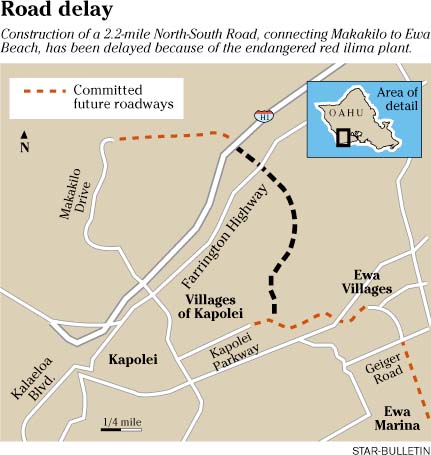
Plan may pave way
for new Ewa roadAt issue is preserving rare red
ilima before starting construction
Seven years after an endangered plant put the brakes on plans for a major roadway in Ewa, a proposal to grow replacement plants could pave the way for road construction.
Yesterday, the Board of Land & Natural Resources released a draft Habitat Conservation Plan for the red ilima, or kooloaula, for review and set a public hearing for 7 p.m. Jan. 28 at Asing Park in Ewa Beach.
COURTESY PHOTO
The red ilima had been assumed extinct on Oahu until 90 plants were discovered in 1996. Since then, state botanists have successfully grown 800 red ilima plants.
The plan must be finalized and become part of a required environmental assessment before the state Department of Transportation can begin construction of the 2.2-mile North-South Road that would connect Makakilo and Ewa Beach, said Ron Tsuzuki, chief planning engineer for state highways.
The North-South Road would link Makakilo Drive on the north with an extended Kapolei Parkway on the south and provide Ewa residents a new H-1 freeway entrance ramp.
Ewa Beach resident Darell Young, a neighborhood board member and state highway planning engineer, said the road is "probably the No. 1 infrastructure concern" for the area.
At issue is the presence of 50 or more red ilima plants on former sugar land where the state wants to put the highway, housing developments and perhaps the University of Hawaii-West Oahu campus.
The Habitat Conservation Plan released yesterday proposes that the state DOT spend $1 million over 20 years to establish and maintain at least three new populations of the red ilima to compensate for destroying it with development.
The woody perennial plant with a small, bright red flower had been assumed extinct on Oahu until 90 plants were discovered in an abandoned cane field in 1996.
Since that time, state botanists have successfully grown 800 red ilima plants. The new plants have been planted near Kaena Point, at the Pearl Harbor National Wildlife Refuge and the Koko Crater Botanical Garden. Others will be planted at Diamond Head State Park and other locations.
Yet an Endangered Species Recovery Committee has concerns about whether the conservation plan will ensure the plant's survival, officials with the Department of Land & Natural Resources noted in their report to the Land Board.
Even if the habitat plan is approved soon, it is unlikely that the first three lanes of the North-South Road could be started before the end of 2004 or completed before 2006, Tsuzuki said yesterday.
Plans call for a six-lane, divided highway, but half of it would be built first, at a cost of $60 million, he said.
The Transportation Department has already given the DLNR $250,000 to finance recovery work on the plant that has been done so far.
The habitat conservation plan is available at the main State Library, the Ewa Beach Library, the DLNR Forestry office and at www.state.hi.us/dlnr/dofaw/pubs/index.html.

